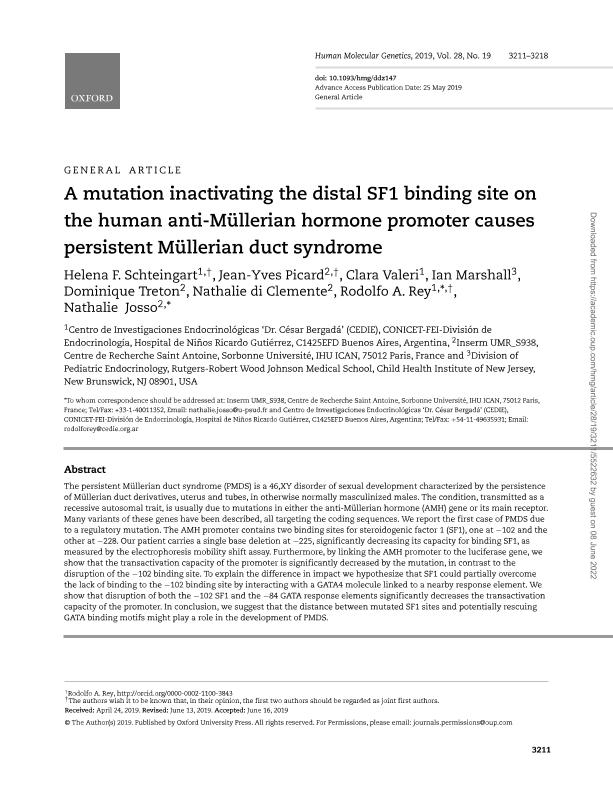Mostrar el registro sencillo del ítem
dc.contributor.author
Schteingart, Helena Fedora

dc.contributor.author
Picard, Jean Yves
dc.contributor.author
Valeri, Clara

dc.contributor.author
Marshall, Ian
dc.contributor.author
Treton, Dominique
dc.contributor.author
di Clemente, Nathalie
dc.contributor.author
Rey, Rodolfo Alberto

dc.contributor.author
Josso, Nathalie
dc.date.available
2022-06-08T04:56:28Z
dc.date.issued
2019-06
dc.identifier.citation
Schteingart, Helena Fedora; Picard, Jean Yves; Valeri, Clara; Marshall, Ian; Treton, Dominique; et al.; A mutation inactivating the distal SF1 binding site on the human anti-Müllerian hormone promoter causes persistent Müllerian duct syndrome; Oxford University Press; Human Molecular Genetics; 28; 19; 6-2019; 3211-3218
dc.identifier.issn
0964-6906
dc.identifier.uri
http://hdl.handle.net/11336/159180
dc.description.abstract
The persistent Müllerian duct syndrome (PMDS) is a 46,XY disorder of sexual development characterized by the persistence of Müllerian duct derivatives, uterus and tubes, in otherwise normally masculinized males. The condition, transmitted as a recessive autosomal trait, is usually due to mutations in either the anti-Müllerian hormone (AMH) gene or its main receptor. Many variants of these genes have been described, all targeting the coding sequences. We report the first case of PMDS due to a regulatory mutation. The AMH promoter contains two binding sites for steroidogenic factor 1 (SF1), one at -102 and the other at -228. Our patient carries a single base deletion at -225, significantly decreasing its capacity for binding SF1, as measured by electrophoresis mobility shift assay. Furthermore, by linking the AMH promoter to the luciferase gene, we show that the transactivation capacity of the promoter is significantly decreased by the mutation, in contrast to disruption of the -102 binding site. To explain the difference in impact we hypothesize that SF1 could partially overcome the lack of binding to the -102 binding site by interacting with a GATA4 molecule linked to a nearby response element. We show that disruption of both the -102 SF1 and the -84 GATA response elements significantly decreases the transactivation capacity of the promoter. In conclusion, we suggest that the distance between mutated SF1 sites and potentially rescuing GATA-binding motifs might play a role in the development of PMDS.
dc.format
application/pdf
dc.language.iso
eng
dc.publisher
Oxford University Press

dc.rights
info:eu-repo/semantics/openAccess
dc.rights.uri
https://creativecommons.org/licenses/by-nc-sa/2.5/ar/
dc.subject
AMH
dc.subject
DSD
dc.subject
UTERUS
dc.subject
TESTIS
dc.subject.classification
Genética Humana

dc.subject.classification
Medicina Básica

dc.subject.classification
CIENCIAS MÉDICAS Y DE LA SALUD

dc.title
A mutation inactivating the distal SF1 binding site on the human anti-Müllerian hormone promoter causes persistent Müllerian duct syndrome
dc.type
info:eu-repo/semantics/article
dc.type
info:ar-repo/semantics/artículo
dc.type
info:eu-repo/semantics/publishedVersion
dc.date.updated
2020-11-06T20:28:54Z
dc.identifier.eissn
1460-2083
dc.journal.volume
28
dc.journal.number
19
dc.journal.pagination
3211-3218
dc.journal.pais
Reino Unido

dc.description.fil
Fil: Schteingart, Helena Fedora. Consejo Nacional de Investigaciones Científicas y Técnicas. Oficina de Coordinación Administrativa Parque Centenario. Centro de Investigaciones Endocrinológicas "Dr. César Bergada". Gobierno de la Ciudad de Buenos Aires. Centro de Investigaciones Endocrinológicas "Dr. César Bergada". Fundación de Endocrinología Infantil. Centro de Investigaciones Endocrinológicas "Dr. César Bergada"; Argentina
dc.description.fil
Fil: Picard, Jean Yves. Inserm; Francia. Sorbonne University; Francia
dc.description.fil
Fil: Valeri, Clara. Consejo Nacional de Investigaciones Científicas y Técnicas. Oficina de Coordinación Administrativa Parque Centenario. Centro de Investigaciones Endocrinológicas "Dr. César Bergada". Gobierno de la Ciudad de Buenos Aires. Centro de Investigaciones Endocrinológicas "Dr. César Bergada". Fundación de Endocrinología Infantil. Centro de Investigaciones Endocrinológicas "Dr. César Bergada"; Argentina
dc.description.fil
Fil: Marshall, Ian. Child Health Institute of New Jersey; Estados Unidos
dc.description.fil
Fil: Treton, Dominique. Sorbonne University; Francia. Inserm; Francia
dc.description.fil
Fil: di Clemente, Nathalie. Sorbonne University; Francia. Inserm; Francia
dc.description.fil
Fil: Rey, Rodolfo Alberto. Consejo Nacional de Investigaciones Científicas y Técnicas. Oficina de Coordinación Administrativa Parque Centenario. Centro de Investigaciones Endocrinológicas "Dr. César Bergada". Gobierno de la Ciudad de Buenos Aires. Centro de Investigaciones Endocrinológicas "Dr. César Bergada". Fundación de Endocrinología Infantil. Centro de Investigaciones Endocrinológicas "Dr. César Bergada"; Argentina
dc.description.fil
Fil: Josso, Nathalie. Inserm; Francia. Sorbonne University; Francia
dc.journal.title
Human Molecular Genetics

dc.relation.alternativeid
info:eu-repo/semantics/altIdentifier/url/https://academic.oup.com/hmg/advance-article/doi/10.1093/hmg/ddz147/5522632
dc.relation.alternativeid
info:eu-repo/semantics/altIdentifier/doi/http://dx.doi.org/10.1093/hmg/ddz147
Archivos asociados
